Grace Robert. Advanced Blowout and Well Control
Подождите немного. Документ загружается.

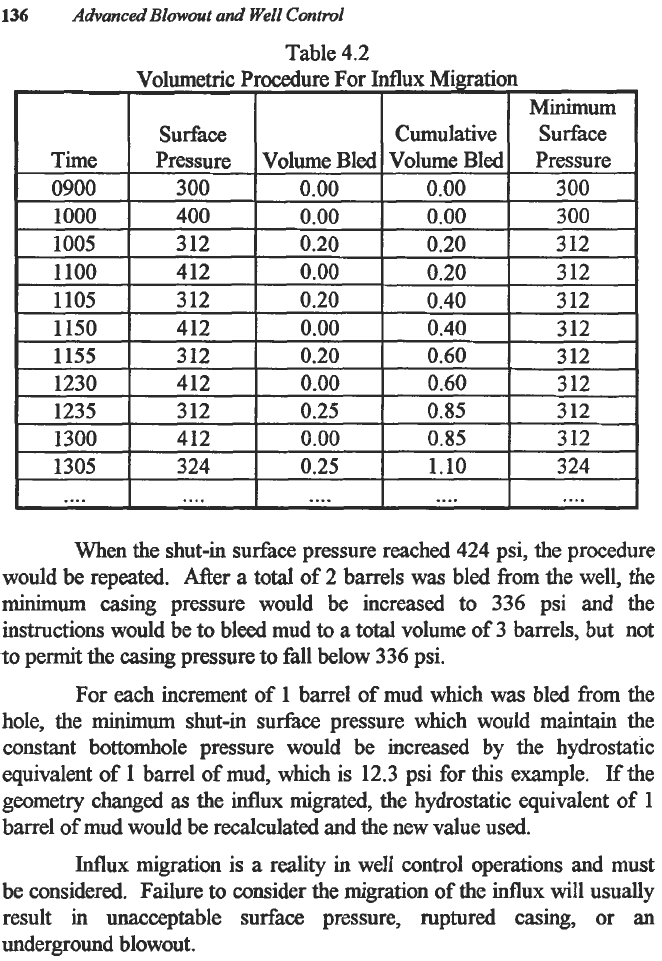
136
Advanced
Blowout
and
Well
Control
Table
4.2
1300
0.00
0.85
1305
324 0.25
1.10
3
24
....
....
....
....
....
When the shut-in surface pressure reached
424
psi, the procedure
would be repeated. Mer a total
of
2
barrels
was
bled from the well, the
minimum casing pressure would be increased to
336
psi and the
instructions would be to bleed mud
to
a total volume
of
3
barrels, but not
to permit the casing pressure to fY1 below
336
psi.
For each increment
of
1 barrel
of
mud which was bled from the
hole, the minimum shut-in surfixe pressure which would
maintain
the
constant
bottomhole pressure would be increased by the hydrostatic
equivalent
of 1 barrel
of
mud, which is
12.3
psi
for
this
example.
If
the
geometry changed
as
the influx migrated, the hydrostatic equivalent
of
1
barrel
of
mud would be recalculated and the new value used.
Influx migration is
a
reality
in
well control operations and must
be considered. Failure to consider the migration
of
the influx will usually
result in unacceptable surface pressure, ruptured casing, or
an
underground blowout.

Special
Conditions,
Problems and Procedures
in
Well
Control
137
SAFETY FACTORS IN CLASSICAL PRESSURE CONTROL
PROCEDURES
It
is well established that the Driller’s Method and the Wait and
Weight Method are based on the classical U-Tube Model
as
illustrated in
Figure 4.1. The displacement concept for all classical procedures
regardless of the name is to determine the bottomhole pressure
from
the
mud density and the shut-in drillpipe pressure and
to
keep
that
bottomhole
pressure constant while displacing the influx. For the conditions given in
Figure 4.4, the shut-in bottomhole pressure would be 5200 psi.
Therefore, as illustrated in Chapter
2,
the goal of the control procedure
would be to circulate the influx out of the wellbore while maintaining the
bottomhole pressure constant at
5200
psi.
One of the
most
serious and fiquent well control problems
encountered in the industry is the inability to bring the influx to the
surface without experiencing an additional influx or causing
an
underground blowout.
In
addition, in the field difficulty is experienced
starting and stopping displacement without permitting
an
additional
influx.
To
address the latter problem, many have adopted “safety factor”
methods.
The application of the “safety Eactors” arbitrarily alters the
classical procedures and
can result
in
potentially serious consequences.
“Safi factors” are usually in
three
forms. The first is in the
form
of
some arbitrary additional drillpipe pressure in excess of the calculated
circulating pressure at the kill speed. The second is an arbitrary increase
in mud density above that calculated
to
control the bottomhole pressure.
The third
is
an arbitrary combination of the
two.
When the term “safety
factor”
is
used, there is generally no question about the validity of the
concept.
Who
could question “safety”? However, arbitrary “safety
factors”
can
have serious effects on the well control procedure
and
can
cause the very problems which they were intended to avoid! Consider
Example 4.5:
ExarnuIe
4.5
Given:
Wellbore schematic
U-Tube schematic
=
Figure4.4
=
Figure
4.7
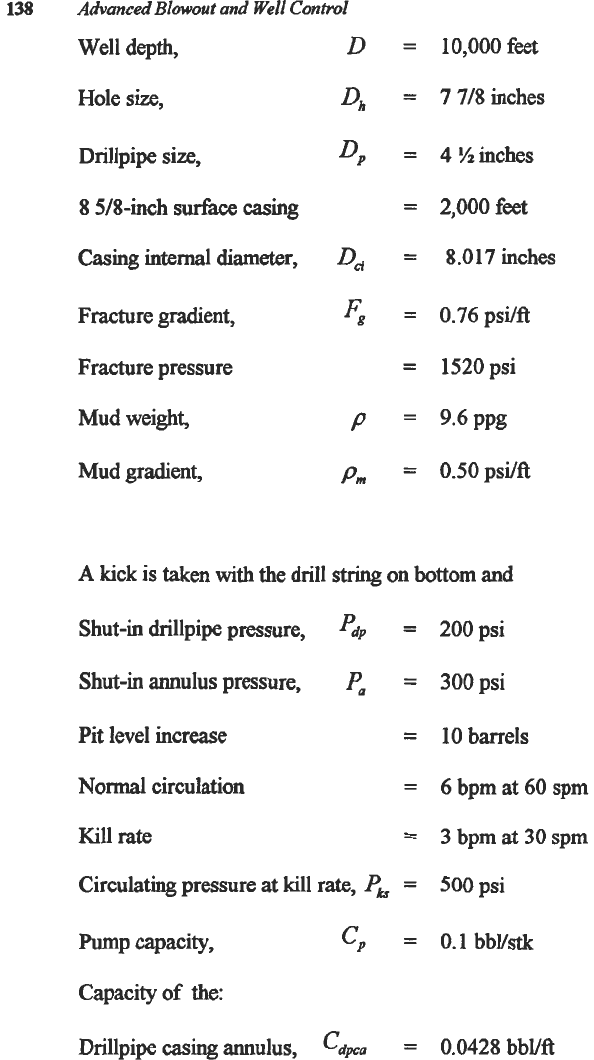
138
Advanced
Blowout
and
Well
Control
Well depth,
D
=
10,OOOfeet
Hole
size,
D,,
=
7
718 inches
Drillpipe
size,
Dp
=
4 %inches
8
518-inch
surface
Casing
=
2,OOOfeet
Casing
internaldiameter,
Dd
=
8.017 inches
Fracture gradient,
5
=
0.76psi/f€
Fracture pressure
=
152Opsi
Mud weight,
P
=
9.6PPg
Mud gradient,
p,,,
=
OSOpsi/ft
A
kick is
taken
with the drill
string
on bottom and
Shut-in drillpipe pressure,
pdp
=
200 psi
Shut-in annulus pressure,
P,
=
300
psi
Pit level increase
=
10 barrels
Nod
circulation
=
6 bpm at 60 spm
Kill
rate
=
3
bpm
at
30
spm
Circulating pressure
at
kill
rate,
Ph
=
Pump capacity,
cp
=
0.1 bbVstk
Capacity
of
the:
Drillpipe
casing
annulus,
cdp~
=
0.0428 bbVft
500
psi
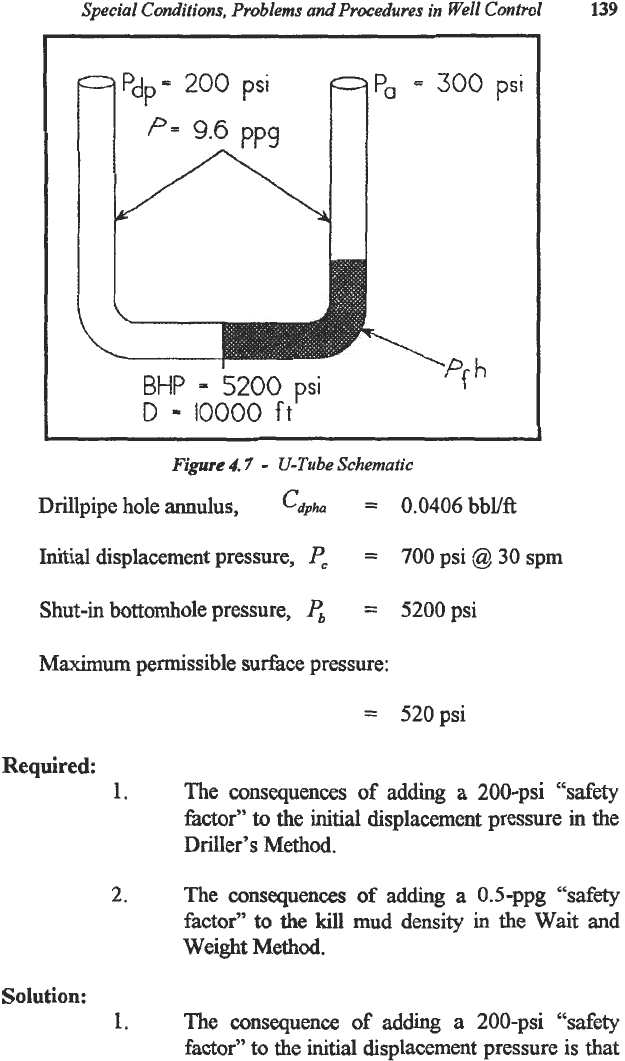
Special
Conditions,
Problems
and
Procedures
in
Well
Control
139
Figure
4.7
-
U-Tube Schematic
Drillpipe hole annulus,
cdpha
=
0.0406
bbVft
Initial displacement pressure,
P,
=
700
psi
@?
30
spm
Shut-in bottomhole pressure,
pb
=
5200
psi
Maximum
permissible surface pressure:
=
52Opsi
Required:
1.
The consequences
of
adding
a
200-psi
“safety
&tor”
to
the initial displacement pressure
in
the
Driller’s
Method.
2.
The consequences
of
adding
a
0.5-ppg “safety
factor”
to
the
kill mud density in
the
Wait and
Weight
Method.
Solution:
1.
The consequence
of
adding a 200-psi “safety
factor” to the initial displacement pressure is that
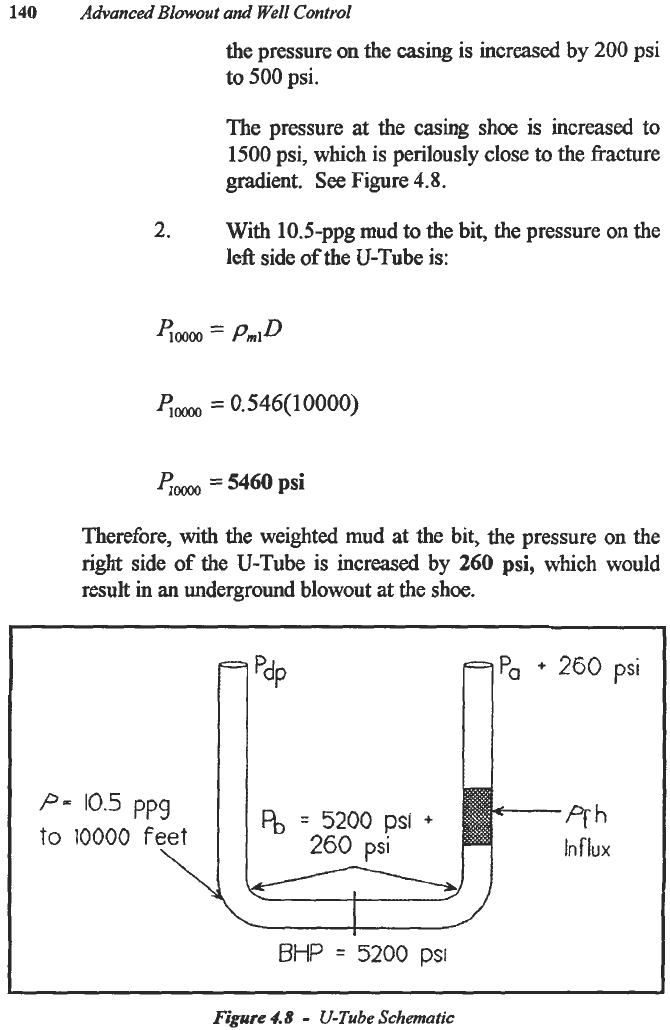
140
Advanced
Blowout
and Well
Control
the pressure on the casing is increased by
200
psi
to
500
psi.
The pressure at the casing
shoe
is
increased to
1500 psi, which is perilously close to the fracture
gradient.
See
Figure
4.8.
2.
With 10.5-ppg mud to the bit, the pressure
on
the
left side of the U-Tube
is:
qm
=
0.546(10000)
qm
=
5460
psi
Therefore,
with
the weighted
mud
at the bit, the pressure on the
right side
of
the U-Tube is increased by 260
psi,
which would
result in
an
underground blowout at the
shoe.
P=
10.5
ppg
to
10000
feet
\
pdP
4
=
5200
psi
+
260
psi
-
BHP
=
5200
psi
Figure
4.8
-
U-Tube
Schematic
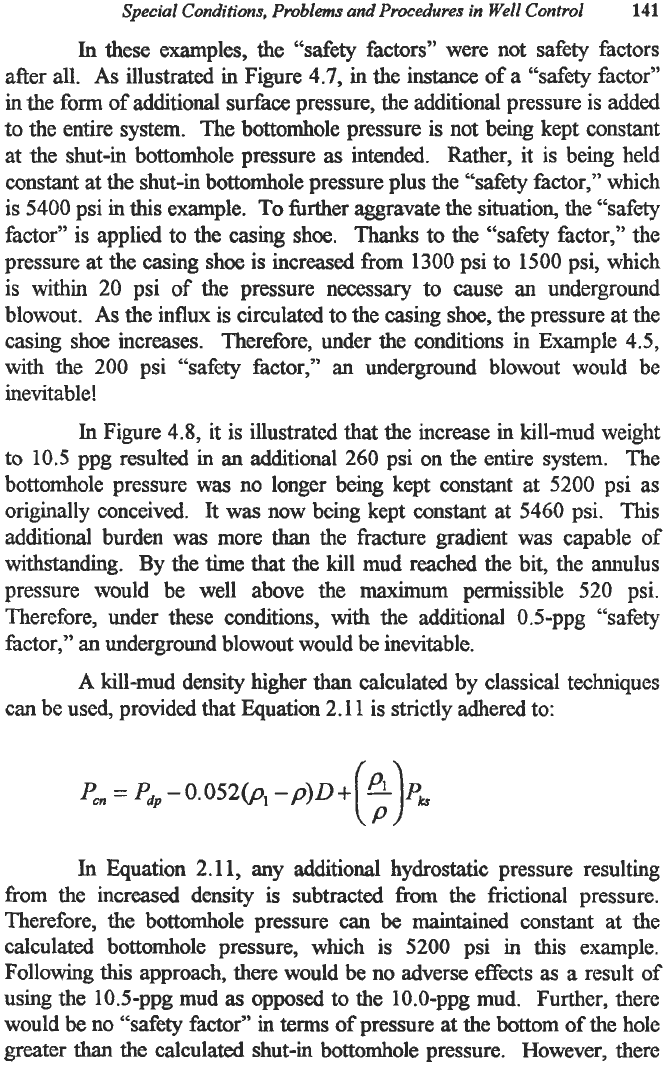
Special Conditions, Problems and
Procedures
in
Well Control
141
In
these examples, the
“safety
factors” were not safety factors
after all.
As
illustrated
in
Figure
4.7,
in
the instance of a
“safii
factor”
in the form of additional surface pressure, the additional pressure is added
to the entire system. The bottomhole pressure is not being kept constant
at the shut-in bottomhole pressure
as
intended. Rather, it
is
being held
constant at the shut-in bottomhole pressure plus the
“safety
factor,” which
is
5400
psi
in
this example.
To
further aggravate the situation, the “safety
factor”
is
applied to the casing
shoe.
Thanks
to the ‘‘safety factor,”
the
pressure at the casing shoe is increased from 1300 psi to 1500 psi, which
is within 20 psi of the pressure
necessary
to cause
an
underground
blowout.
As
the influx is circulated to the casing shoe, the pressure at the
casing shoe increases. Therefore, under the conditions in Example
4.5,
with the
200
psi “safety factor,” an underground blowout would be
inevitable!
In
Figure
4.8,
it is illustrated that the increase in kill-mud weight
to
10.5
ppg resulted
in
an additional
260
psi on the entire system. The
bottomhole pressure
was
no longer being kept constant
at
5200
psi as
originally conceived. It
was
now bcing kept constant at
5460
psi.
This
additional burden was more
than
the fracture gradient was capable of
withstanding. By the time
that
the kill mud reached the bit, the annulus
pressure would be well above the
maximum
permissible
520
psi.
Therefore, under these conditions,
with
the additional 0.5-ppg “safety
factor,”
an
underground blowout would be inevitable.
A
kill-mud density higher than calculated by classical techniques
can
be used, provided that Equation 2.1
1
is strictly adhered to:
In
Equation 2.11, any additional hydrostatic pressure resulting
from the increased density is subtracted from the frictional pressure.
Therefore, the bottomhole pressure can
be
maintained constant at the
calculated bottomhole pressure, which is
5200
psi in this example.
Following
this
approach, there would be no adverse effects
as
a result
of
using the 10.5-ppg mud
as
opposed to the 10.0-ppg mud. Further, there
would
be
no “safety factor”
in
terms of pressure at the bottom of the hole
greater
than
the calculated shut-in bottomhole pressure. However, there
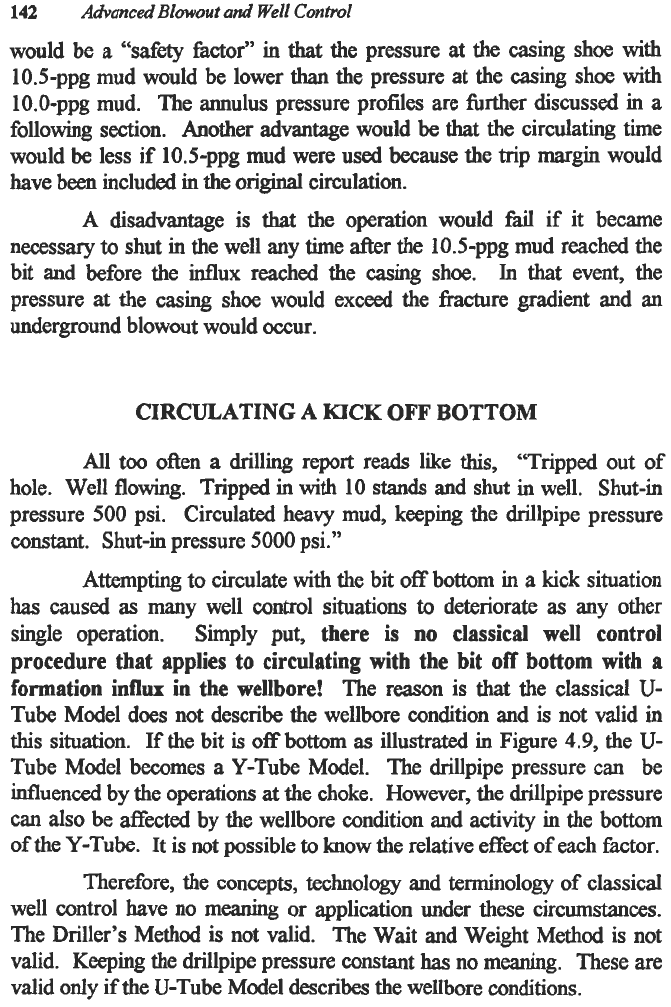
142
Advanced
Blowout
and
Well
Control
would be
a
“safety
fbctor” in
that
the pressure at the casing shoe with
10.5-ppg mud would be lower
than
the pressure at the casing shoe with
10.0-ppg mud. The annulus pressure profiles are fbrther discussed in
a
following section. Another advantage would be
that
the circulating time
would
be
less if 10.5-ppg mud were used because the
trip
margin would
have been included
in
the
on@
circulation.
A
disadvantage is that the operation would
fhil
if it became
necessary
to
shut in the well any time after the 10.5-ppg mud reached the
bit and before the influx reached the casing shoe.
In
that event, the
pressure
at
the casing shoe would exceed the fracture gradient and an
underground blowout would occur.
CIRCULATING A KICK OFF
BOTTOM
All
too
often
a
drilling
report
reads like
this,
“Tripped out of
hole. Well flowing. Tripped in with 10
stands
and shut in well. Shut-in
pressure
500
psi. Circulated heavy mud, keeping the drillpipe pressure
constant. Shut-in pressure
5000
psi.”
Attempting to circulate with the bit
off
bottom in a kick situation
has
caused
as
many well control situations to deteriorate
as
any other
single operation. Simply put,
there is no classical well control
procedure that applies to circulating with the bit
off
bottom
with a
formation influx in
the
wellbore!
The reason is that the classical
U-
Tube Model does not describe the wellbore condition and is not valid in
this
situation. If the bit
is
off
bottom
as
illustrated in Figure
4.9,
the U-
Tube Model becomes a Y-Tube Model. The drillpipe pressure can be
influenced by the operations
at
the choke. However, the drillpipe pressure
can
also
be affected by the wellbore condition and
activity
in the bottom
of the Y-Tube. It is not possible
to
know the relative effect of each f8ctor.
Therefore, the concepts, technology and terminology of classical
well control have no
meaning
or application under these circumstances.
The Driller’s Method is not valid. The Wait and Weight Method is not
valid. Keeping the drillpipe pressure constant
has
no
meaning.
These
are
valid
only
if the U-Tube Model describes the wellbore conditions.
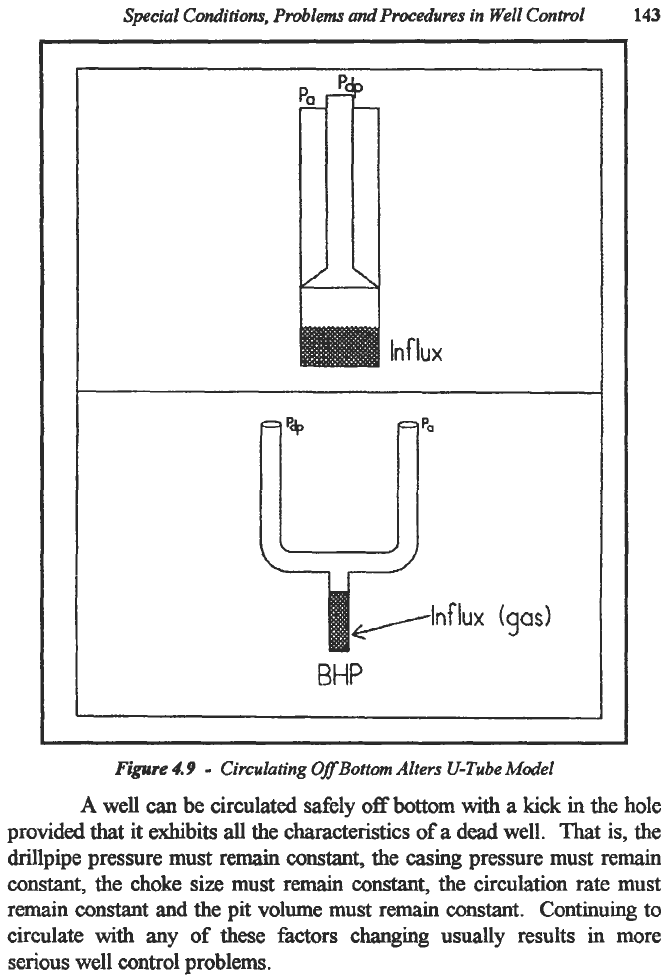
Special Conditions, Problems
and
Procedures
in
Well
Control
143
b
RHP
Figure
4.9
-
Circulating
OflBottom
Alters U-Tube Mdel
A
well
can
be circulated safely
off
bottom with
a
kick
in
the hole
provided that it exhibits
all
the characteristics of
a
dead well. That is, the
drillpipe pressure must remain constant, the casing pressure must remain
constant, the choke size must remain constant, the circulation rate must
remain constant
and
the pit volume must remain constant. Continuing to
circulate with any
of
these factors changing usually results in more
serious well control problems.
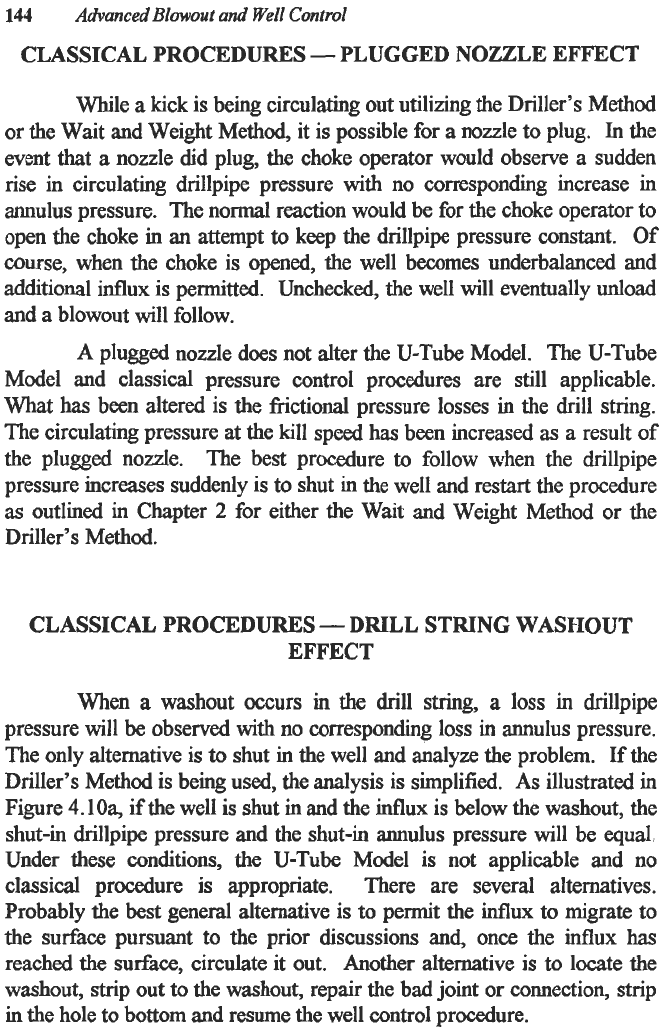
144
Advanced
Blowout
and
Well
Control
CLASSICAL PROCEDURES
-
PLUGGED NOZZLE EFFECT
While
a
kick is being circulating out utilizing the Driller’s
Method
or the Wait and Weight Method, it is possible for a nozzle to plug.
In
the
event that
a
nozzle did plug, the choke operator would observe a sudden
rise in circulating drillpipe pressure with no corresponding increase in
annulus pressure. The normal reaction would be for the choke operator to
open the choke in an attempt
to
keep the drillpipe pressure constant. Of
course, when the choke is opened, the well becomes underbalanced and
additional influx is permitted. Unchecked, the well will eventually
unload
and a blowout will follow.
A
plugged nozzle does not alter the U-Tube Model. The U-Tube
Model and classical pressure control procedures are
still
applicable.
What has been altered is the
frictional
pressure losses in the drill string.
The circulating pressure at the kill speed
has
been increased
as
a result of
the plugged nozzle. The best procedure
to
follow when the drillpipe
pressure increases suddenly
is
to shut in the well and restart the procedure
as
outlined in Chapter
2
for either the Wait and Weight Method or the
Driller’s Method.
CLASSICAL PROCEDURES
-
DRILL STRING WASHOUT
EFFECT
When
a
washout occurs
in
the
drill
string,
a
loss in drillpipe
pressure
will
be observed with no corresponding loss in annulus pressure.
The only alternative is
to
shut in the well and analyze the problem. If the
Driller’s Method is being used, the analysis is simplified.
As
illustrated
in
Figure
4.
loa,
if the well is shut in and the influx is below the washout, the
shut-in drillpipe pressure and the shut-in annulus pressure will be
equal
Under these conditions, the U-Tube Model is not applicable and no
classical procedure
is
appropriate. There are several alternatives.
Probably the best general alternative is
to
permit the influx to migrate to
the surface pursuant to the prior discussions
and,
once the influx
has
reached the sufice, circulate it out. Another alternative
is
to locate the
washout, strip out to the washout, repair the bad joint or connection, strip
in the hole to bottom and resume the well control procedure.
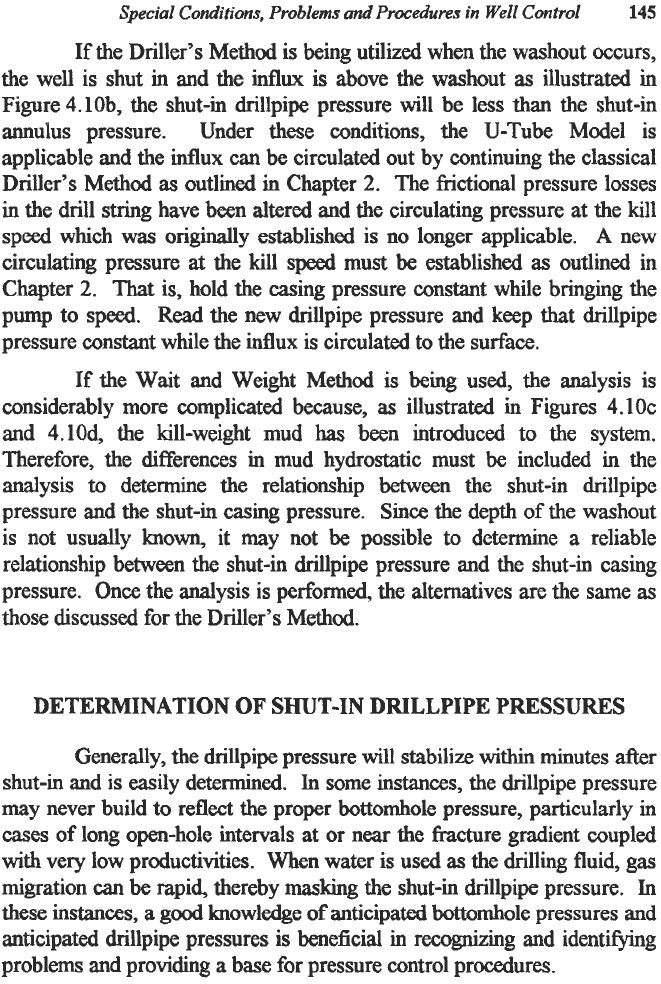
Special Conditions, Problems
and
Procedures in Well
Control
145
If
the Driller’s Method is being utilized when the washout occurs,
the well is shut in and the influx is above the washout
as
illustrated
in
Figure 4.10b, the shut-in drillpipe pressure will be less than the shut-in
annulus pressure. Under these conditions, the U-Tube Model
is
applicable and the
influx
can be circulated out by continuing the classical
Driller’s Method
as
outlined in Chapter
2.
The frictional pressure losses
in the drill string have been altered and the circulating pressure at the kill
speed which
was
originally established
is
no
longer applicable. A new
circulating pressure
at
the kill
speed
must
be
established
as
outlined in
Chapter
2.
That
is, hold the casing pressure constant while bringing the
pump to speed.
Read
the new drillpipe pressure and keep that drillpipe
pressure constant while the influx is circulated to the surface.
If
the Wait and Weight Method is
being
used,
the analysis is
considerably more complicated because,
as
illustrated in Figures 4.10~
and 4.10d, the kill-weight mud
has
been introduced to the system.
Therefore, the differences in mud hydrostatic must be included in the
analysis
to
determine the relationship between the shut-in drillpipe
pressure and the shut-in casing pressure. Since the depth of the washout
is not usually
known,
it may not
be
possible to
determine
a reliable
relationship between the shut-in drillpipe pressure and the shut-in casing
pressure. Once the analysis
is
perfonneed, the alternatives are the same
as
those discussed for the Driller’s Method.
DETERMINATION
OF
SHUT-IN DRILLPIPE
PRESSURES
Generally, the drillpipe pressure will stabilize
within
minutes after
shut-in and is easily determined.
In some instances, the drillpipe pressure
may
never build to reflect the proper bottomhole pressure, particularly in
cases
of
long open-hole intervals at or near the fracture gradient coupled
with very low productivities. When water
is
used
as
the drilling fluid, gas
migration
can
be
rapid, thereby masking the shut-in drillpipe pressure.
In
these
instanas,
a
good
knowledge
of
anticipated bottomhole pressures
and
anticipated drillpipe pressures
is
beneficial in recognizing and identifjmg
problems and providing a base for pressure control procedures.
